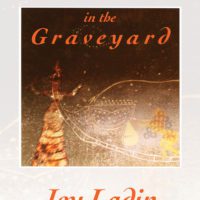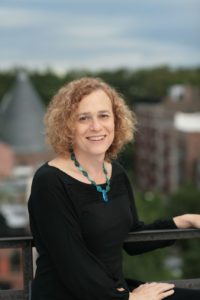The title of Joy Ladin’s latest poetry collection, Fireworks in the Graveyard, juxtaposes death with explosive celebration, the perfect metaphor for turning conflict—in this case, a conflict of identity—into rebirth. Jane Hirshfield, in Ten Windows: How Great Poems Transform the World, poses the question, “Why ask art into a life at all, if not to be transformed and enlarged by its presence and mysterious means?” Indeed, “transformed and enlarged” may be a tall order, but Ladin is more than up to the task, her whole life essentially necessitating transformation and transcendence, which reflects in her striking and regenerative poetry. Her struggles in transitioning from man to woman, most poignantly the effect of this on her children and wife who knew her as a man, are complemented by her deeply religious side, grounded in her Judaic faith. The dialectic between life and death, suggested in the title of this collection, is powerfully sourced in her experience of two significant forces in her life: the force of faith and that of identity, in her case against the identity of her own body.
In an interview with Krista Tippett on the PBS conversation and podcast On Being, Ladin says, “…what really drew me to Judaism was that, like many trans kids, I had an intense sense of God as a real, living, constant presence.” The phrase “like many trans kids” stood out for me: someone I know and love personally is also trans, and one of the most highly spiritual people I’ve ever known. Yet I never thought of there being a connection between religiosity and being at odds with one’s physical gender identity.
She elaborates further:
…the Torah includes one really genderless character and that’s God. Because despite the male pronouns, God doesn’t have a body. And, when I was a kid, that was a very powerful, not really articulated sense of connection that I had. Because I had male pronouns, but I didn’t feel like I had a body.
As Tippett points out, Ladin writes that her “body felt like a cross between a mask and a tomb,” reminiscent of the title’s “graveyard,” a place where her self is buried. This sense of not having a body is vividly portrayed in “Corpus”:
I want to say goodbye to my body
before my body says goodbye to me.
We’ve never properly been introduced. I always call my body “body;”
my body never calls me at all.
Here she treats her body as a foreign object or third party, a disconnect that creates a sense of not exactly being a “self” either, as in “Summering”:
It’s hard to make small talk when the subject disappears. Excuse me,
have you seen my “I”?
Did it buy you drinks last night,
give you shivers,
stumble out at dawn, tail between its legs…?
This humorous play on identity calls to mind Emily Dickinson’s “I’m Nobody,” but Ladin takes the sense in an entirely different direction, where it is not one’s social identity that is recalibrated, but one’s personal, physical identity that is not only reevaluated but undergoes a literal metamorphosis of the most visceral kind. The identity disconnect itself feels like death or simply nonexistence.
But death does not occur in a vacuum. The title poem shows us even the cemetery is full of personal relationships—“a family sprawls on blankets: / toddler sobs, sibling ahs, parents, stiff and a little chilly…”—where “the dead have the night off, they don’t celebrate with / explosions.” Nonexistence is not an option for the living. The poet zeroes in on the pain of changing one’s identity and the effect of this change on, for example, “the son who turns away when I wave,”
telling a story that is not unlike my life
to a sky as distant as the ear
of the man my young son loved
when I was not unlike his father.
To deal with such wrenching emotions, Ladin’s poetry aims higher, toward larger issues, and with wider, more universal observations, to set her story within common experience and its wisdom, as in “I-95”:
We’re heading south, sun in our eyes, stuck in traffic,
outdistanced by a dragonfly.
No one’s moving, but everyone will arrive.
That’s the nature of heaven and highways.
That’s the nature of time.
…
Pieces of heaven are tumbling toward us,
shards of sunlight igniting yesterday’s puddles.
…
We’re moving now, rolling through space and time
at many lives per hour. There’s a village up ahead, a marina, a bridge,
a flock of neatly nested condos, very exclusive, almost uninhabited…
Driving down the freeway takes on cosmic significance; suddenly it’s “heaven and highways” having the same nature, “the nature of time.” It’s not a highway to heaven but a heaven literally coming to the highway: “pieces of heaven are tumbling toward us.” Light is “a piece of heaven” or the sky. Meanwhile, moving at “many lives per hour,” the trip down the interstate becomes a time-tunnel, a channeling of lives past and present. One passes objects as omens or talismans of some as yet undetermined destiny. The stasis of rush hour becomes the rush itself as traffic clears. We are no longer ordinary, no longer bored. The world is practically bristling with meaning yet to be discovered.
Such meaning pairs emotional experience with intellect and philosophical musings to explore life and death at the point of intersection, as in the exquisite “Aubade: After All”:
After all, I may not be dying, the dying I feel may only be
the dying part of me,
the part that’s always dying.
…
[S]ouls in the neighborhood graveyard
savor the subtly differing chills
of dirt and grief and granite.
The sound of what survived the night
furrows the silence of what didn’t,
waking me
to the not-so-complicated fact
that I may not be dying after all,
that life may be all there is.
This is an astonishing observation coming on the heels of the graveyard and the “dying part of me.” If there is indeed a “dying part” and a graveyard, how can life be all there is? But what Ladin asserts here is not so much the negation of death, as the supremacy of life over death; of survival over destruction; an assertion that death itself is a part of life, rather than being its “conqueror.” This is a profoundly religious observation in the best sense of the word. The death of one gender and its physical embodiment becomes a rebirth as the “opposite” gender. This is “not unlike” a phoenix, and yet Ladin philosophically and poetically explores her own regrets as well. Here in “Departure,” she ruminates over a copy of Hegel’s Phenomenology of the Spirit on the dashboard of a bus:
Hegel’s dialectic ripens, synthesizing age and youth,
eternity and sweet September breeze.
Now that my life is almost over, I wish I’d been better,
more dialectical in my contradictions,
like that tree over there, spinning light into sugar…
Note the weaving of Hegel’s book into a metaphor for the melding of opposites into something new. Ladin wants a better rebirth, something closer to photosynthesis, which brilliantly illustrates Hegel’s “dialectic,” down to the word “synthesis,” the idealized creation of symphony from dissonance or of life-force from breakdown.
To “ameliorate” the desire for death or the sense of self-annihilation, Ladin finds in religion a way of reconciliation, not only within herself, but also with her community and society at large. This makes her work a sequel to Dickinson’s “I’m Nobody,” an affirmation of identity which, unlike Dickinson, Ladin actively asserts in the problematic real world around her. A powerful dialectic brings grace in the found poem, “Amelioration of a Dream,” whose words were reworked from “a traditional Jewish ritual for comforting someone afflicted by a nightmare”:
In this good, this very good, dream,
God’s foot doesn’t falter, God’s help doesn’t slumber,
you see the goodness of those who harm you,…
the good that delights and establishes a household
where curses become a blessing…
you make known the next morning
to three good friends to whom it isn’t sacrilege to say
that goodness can be disturbing.
When “goodness” means honestly living as one’s true identity, which in turn oversteps what society or religion has set up as sacred borders, that goodness is disturbing, and what tradition would call a curse becomes a blessing to the soul freed from its incompatible body. This, too, forms a marriage of contradictions, one complicated further by the relationships it disrupts. But what is most significant here is that the poem itself is the vehicle of reconciliation and a means of healing, a prayer.
Here lies the power of this collection, not only in the fireworks of imagery and language’s legerdemain, but in the depth of its wisdom and the conclusions she reaches. As Ladin puts it in “Balance”: “The little void I held inside / opens into sky.”
Or from “Sabbath”:
The unforgiving and the unforgivable
walked behind me, holding hands.
Listen, the blossoming evening sang,
you have no reason not to die,
but you have reasons to live.
Here is transformation at its best: a journey into the unknown and treacherous inner and outer struggle to be one’s own person that results in triumph over the “death” of self-negation, expressed in words fully realized. Ladin gives us every reason to invite her art, this book, into our lives, not only for its considerable beauty, craft and range of emotion, but for her visionary voice which infuses these poems, enlarging our lives too with its indefatigable presence.





